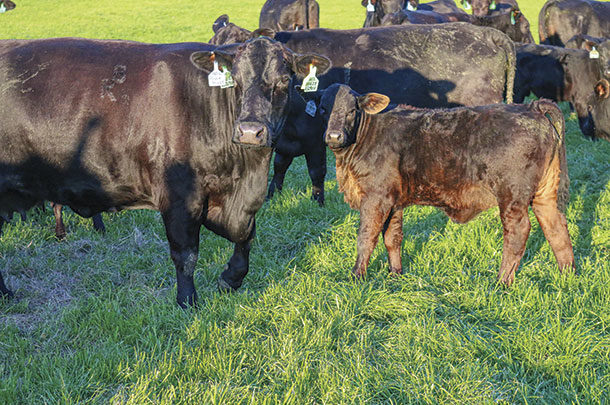Breeding expense, veterinary costs and other expenses do occur, but they tend to be significantly less than the “Big Three.” To conduct an economic analysis, breaking the ranch into enterprises helps everyone understand where value is being created and costs are occurring. On many ranches, four of the major enterprises include land ownership, hay production, cow-calf and replacement heifer development.
Feed
Grazed and harvested feed usually account for 40% to 70% of annual cow costs. If the ranch is owned, the cash cost for feed may be less than that. However, when conducting an economic analysis, grazed and harvested feed from owned land should be valued at market price. In other words, the cow-calf enterprise is asked to pay fair market value for the grass grazed and the hay fed. If the land is owned, the market value of the grass is a return to the land enterprise.
The same goes for hay raised on the ranch. What is the market value for the same quality of hay if you were to sell it off the ranch? The cow-calf enterprise should be asked to pay that value to the hay enterprise. If the market value of the grass cows graze or the hay they are fed is not being accurately accounted for, then the cow-calf enterprise may actually be subsidized by other ranch enterprises.
Labor and equipment
When categorizing costs to the cow herd, labor and equipment can be lumped together as a category because they often go hand in hand. Equipment is often purchased to reduce the need for labor, and labor is needed to operate equipment. These two things together are also often identified as a fixed cost or an overhead cost.
An overhead cost is an expense that doesn’t change very much based on the number of cows in the herd. For example, if a rancher has 200 cows, leases a neighbor’s place and is now able to run an additional 100 cows, that rancher is probably not going to need another pickup, trailer, tractor or ATV just because they added 100 cows. The equipment they had to care for 200 cows is likely adequate to care for 300 cows.
Overhead costs related to labor and equipment tends to be the second-largest expense for the cow herd after feed. When a rancher is serious about addressing annual cow costs, overhead expenses per cow unit is an area where there is often opportunity to improve. Increasing the number of cows per person or equipment, or aggressively finding ways to reduce the equipment and labor needed to care for cows are two ways to address this cost.
Cow depreciation
Cow depreciation is an economic cost often overlooked on many ranches. Many ranchers raise their own replacement heifers, and the costs associated with getting a bred heifer into the cow herd are often hidden. In an economic analysis, identify the market value of the heifer calf at weaning and then account for all additional costs from weaning until she enters the herd as a bred female. Heifer market value at weaning is a value generated by the cow-calf enterprise.
When a bred heifer enters the cow herd, that market value minus her weaned heifer market value provides the amount of value generated by the replacement heifer development enterprise. The heifer calf could have been sold at weaning or she could have been sold after being developed as a bred replacement heifer. Knowing the economic cost of developing a replacement heifer can give insight into understanding where value is being created on the ranch and where costs are occurring. If the market value of a bred replacement heifer is less than what it costs the ranch to develop her, buying replacements may be a better option.
Cow depreciation expenses for a cow-calf enterprise can be addressed in three ways. The first is to reduce the cost to get a cow into the herd. The second is to create and capture more value from a cow when she leaves the herd. The third is to find ways to increase the number of years a cow is productive in the herd. For many ranchers, creatively finding ways to reduce or even eliminate cow depreciation can significantly reduce annual cow costs.
To get a quick picture of the cost of cow depreciation when the herd inventory is remaining constant annually, compare the market price of bred females entering the herd to the revenue generated by cows leaving the herd. Don’t forget to include death loss when counting the cows that leave the herd. If bred heifers have a market value of $1,500 and cull cows leaving the herd are valued at $700, this is $800 of depreciation. If a cow is on average in the herd for four years, this is a cost of $200 per year for cow depreciation.
As 2020 comes to an end, take some time to evaluate all the costs associated with the cow-calf enterprise. In particular, look at the “Big Three” of feed, labor and equipment, and cow depreciation. Consider where there may be opportunities to make changes to improve profitability in the upcoming year. Then develop a strategy and plan to implement them. The relationship between input costs and value of production need to be continually evaluated.








